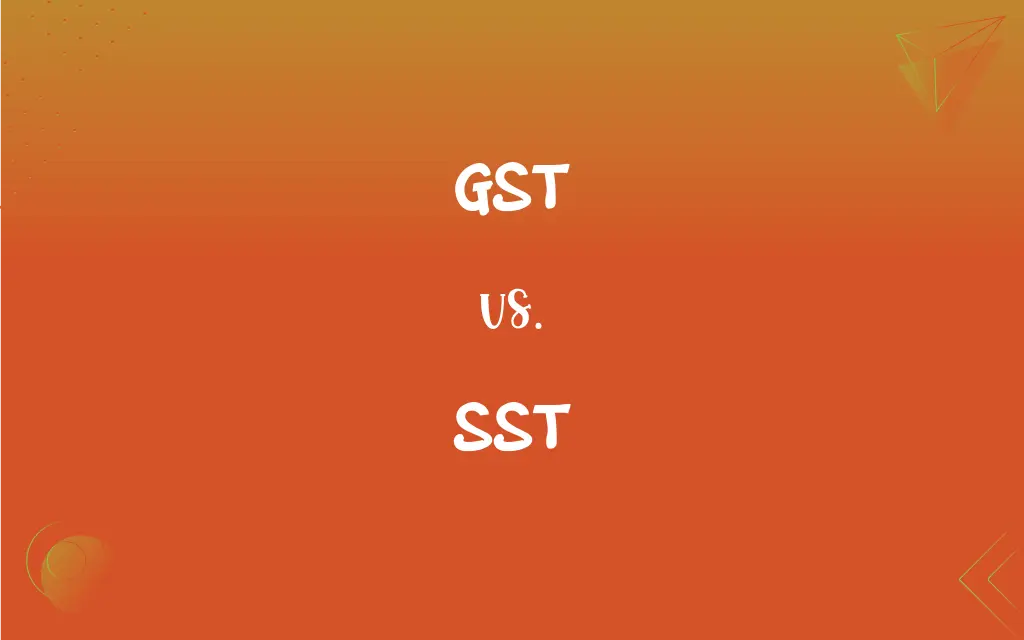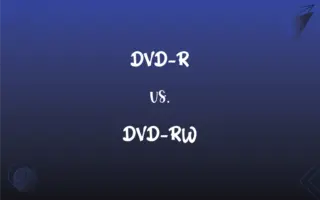GST vs. SST: What's the Difference?
Edited by Aimie Carlson || By Harlon Moss || Published on December 12, 2023
GST (Goods and Services Tax) is a comprehensive, multi-stage tax on the value addition at each stage of production or service delivery, while SST (Sales and Service Tax) is a single-stage tax levied at the point of sale or service provision.

Key Differences
GST, a value-added tax, is charged at every step of the supply chain, with final consumers bearing the tax, while SST is imposed only at the final stage of the supply chain, typically at the point of sale.
GST allows businesses to claim credit for the taxes paid on their purchases, creating a chain of tax credits, whereas SST does not usually provide a mechanism for input tax credit.
Under GST, both goods and services are taxed under a single unified system, offering a comprehensive tax structure, while SST often differentiates between the taxation of goods (sales tax) and services (service tax).
GST implementation simplifies the tax structure by replacing multiple indirect taxes, whereas SST can coexist with other indirect taxes, leading to a potentially more complex tax system.
In GST, tax liability transfers across the supply chain, which reduces tax evasion, whereas in SST, being a single-stage tax, the likelihood of tax evasion can be higher.
ADVERTISEMENT
Comparison Chart
Stage of Taxation
Multi-stage (at each supply chain level)
Single-stage (at point of sale/service)
Tax Credit Mechanism
Allows input tax credits
No input tax credit mechanism
Tax Structure
Unified for goods and services
Separate for goods (sales tax) and services (service tax)
Tax Complexity
Simplifies by replacing multiple taxes
Can coexist with other taxes, potentially more complex
Tax Evasion
Reduced due to chain of credits
Higher possibility due to single-stage nature
ADVERTISEMENT
GST and SST Definitions
GST
GST replaces several indirect taxes like VAT, excise duty, and service tax.
The introduction of GST simplified the indirect tax structure in the country.
SST
SST is a single-stage tax applied to the sale of goods or provision of services.
The SST on restaurant services is added to the final bill.
GST
GST is levied at each stage of the production and distribution process.
Each supplier in the chain pays GST on their inputs and charges it on their outputs.
SST
SST is simpler to administer but can be less efficient compared to GST.
Although simpler, SST might not be as effective in preventing tax evasion.
GST
GST aims to eliminate the cascading effect of taxes on goods and services.
By allowing input tax credit, GST reduces the overall tax burden on goods.
SST
SST comprises sales tax on goods and service tax on services.
SST in the automotive industry primarily impacts the sales price of vehicles.
GST
GST is a destination-based tax, where the tax is collected by the consuming state.
GST revenues are shared between the manufacturing and consuming states.
SST
SST is usually levied at the retail level or final point of sale.
Retailers charge SST on consumer goods at the point of purchase.
GST
GST is a multi-stage, comprehensive tax on the supply of goods and services.
The GST on electronic goods increases the final retail price.
SST
SST does not allow for input tax credit, leading to potential tax cascading.
The lack of input tax credit under SST can lead to higher costs for consumers.
FAQs
Can GST prevent tax cascading?
Yes, GST eliminates the cascading effect of taxes through input tax credits.
Is SST easier to administer than GST?
Yes, SST is generally simpler to administer due to its single-stage nature.
Can consumers claim GST credits?
No, only businesses can claim GST credits, not end consumers.
Does SST increase the final cost to consumers?
SST can increase final costs due to the lack of input tax credits.
How is SST different from GST?
SST is a single-stage tax levied at the point of sale or service provision.
Why might businesses prefer GST over SST?
Businesses might prefer GST due to input tax credit benefits.
Does GST replace other indirect taxes?
Yes, GST replaces several indirect taxes like VAT and excise duty.
Is SST applicable on exported goods?
Typically, exported goods are exempt from SST.
How does GST affect state revenues?
GST revenues are shared between manufacturing and consuming states.
Are exports subject to GST?
Generally, exports are zero-rated under GST.
Is SST better for small transactions?
SST can be simpler for small transactions due to its straightforward nature.
What is GST?
GST is a comprehensive, multi-stage tax on goods and services.
Are small businesses exempt from GST?
There are exemptions for small businesses under GST, depending on the threshold.
Does SST apply to both goods and services?
Yes, SST applies to both goods (sales tax) and services (service tax).
Does SST contribute to tax cascading?
Yes, SST can lead to tax cascading as it doesn't allow input tax credits.
Can GST rates vary for different goods?
Yes, GST rates can vary based on the type of good or service.
Are services taxed under SST?
Yes, services are taxed under the service tax component of SST.
How does GST affect pricing strategies?
GST affects pricing by including tax in the value chain of products.
Is compliance with SST simpler than with GST?
Yes, SST typically involves simpler compliance compared to GST.
How does GST impact inter-state trade?
GST facilitates smoother inter-state trade by reducing tax barriers.
About Author
Written by
Harlon MossHarlon is a seasoned quality moderator and accomplished content writer for Difference Wiki. An alumnus of the prestigious University of California, he earned his degree in Computer Science. Leveraging his academic background, Harlon brings a meticulous and informed perspective to his work, ensuring content accuracy and excellence.
Edited by
Aimie CarlsonAimie Carlson, holding a master's degree in English literature, is a fervent English language enthusiast. She lends her writing talents to Difference Wiki, a prominent website that specializes in comparisons, offering readers insightful analyses that both captivate and inform.







































































